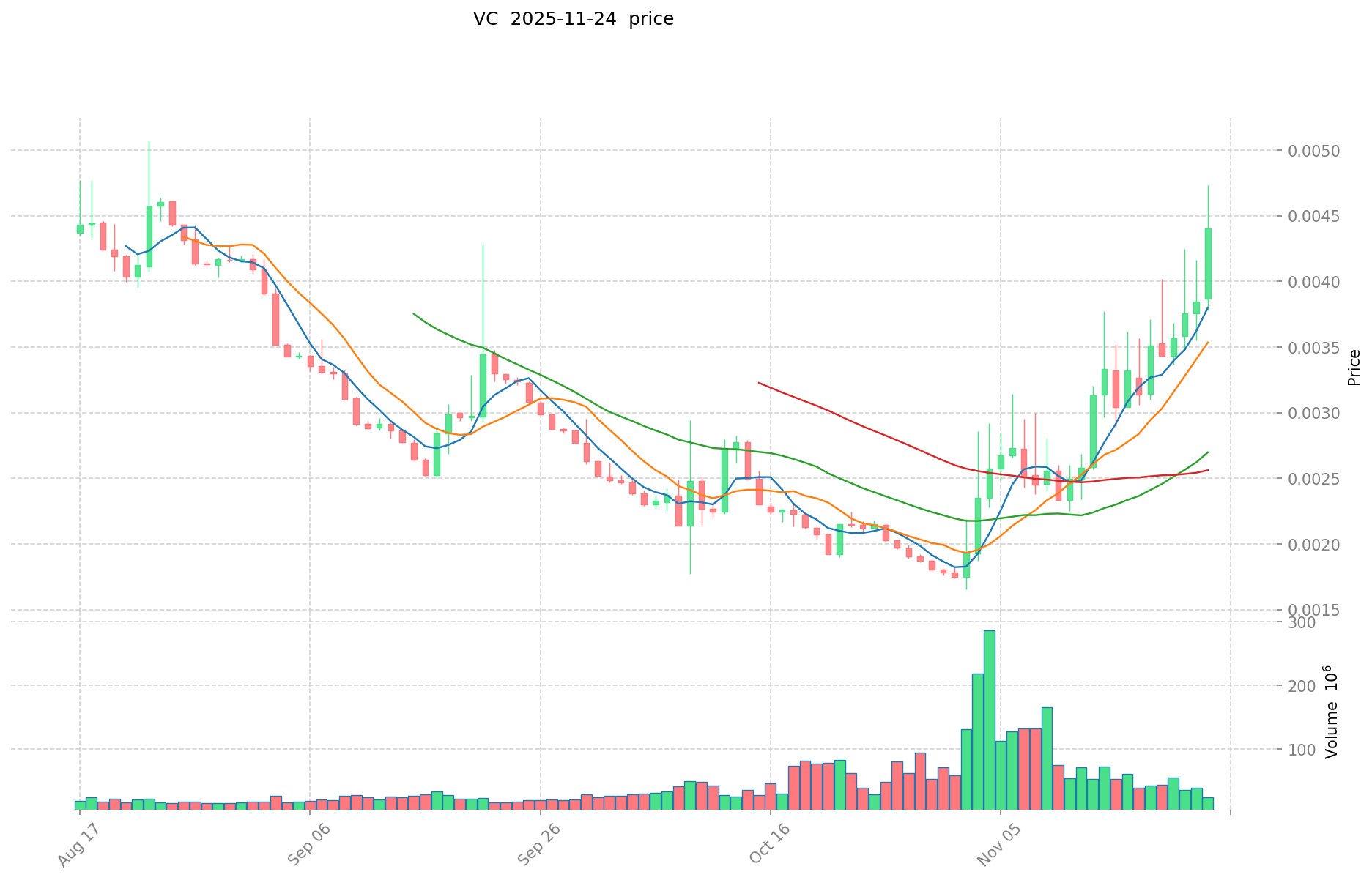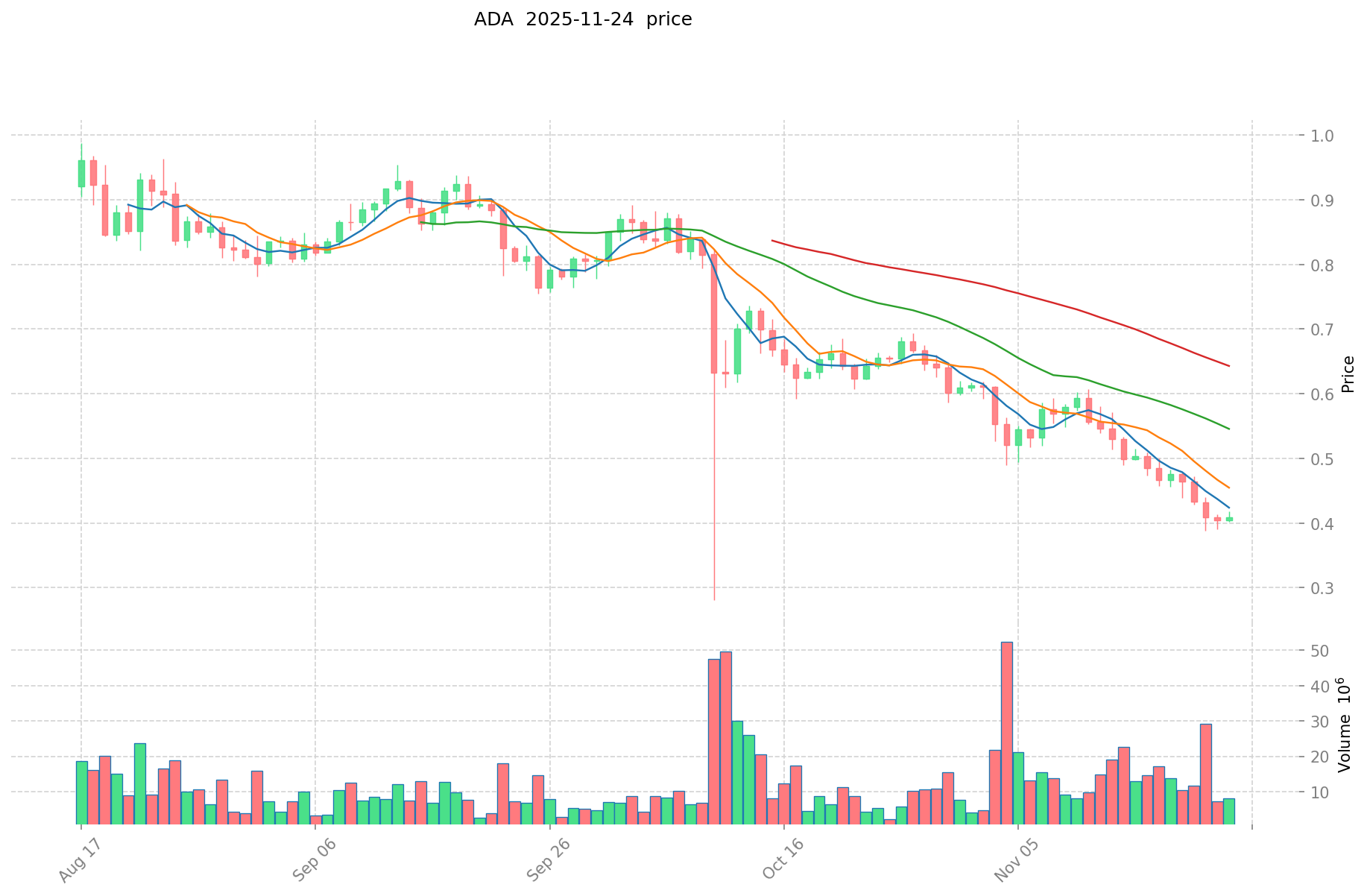VC vs ADA: The Battle for Cryptocurrency Supremacy in the Digital Age
Introduction: Investment Comparison of VC vs ADA
In the cryptocurrency market, VinuChain vs Cardano has been an unavoidable topic for investors. The two not only show significant differences in market cap ranking, application scenarios, and price performance, but also represent different positioning in crypto assets.
VinuChain (VC): Since its launch, it has gained market recognition for its DAG-based EVM chain with one-second finality and near-infinite scalability.
Cardano (ADA): Introduced in 2017, it has been hailed as a technology platform capable of running financial applications used by individuals, organizations, and governments worldwide.
This article will comprehensively analyze the investment value comparison between VinuChain and Cardano, focusing on historical price trends, supply mechanisms, institutional adoption, technological ecosystems, and future predictions, attempting to answer the question investors care about most:
"Which is the better buy right now?"
I. Price History Comparison and Current Market Status
VinuChain (VC) and Cardano (ADA) Historical Price Trends
- 2023: VC reached its all-time high of $0.25 on December 18, 2023.
- 2025: VC hit its all-time low of $0.001651 on November 2, 2025.
- Comparative analysis: In this market cycle, VC has fallen from its peak of $0.25 to its current price of $0.004643, while ADA has declined from its all-time high of $3.09 (reached on September 2, 2021) to $0.4117.
Current Market Situation (2025-11-24)
- VC current price: $0.004643
- ADA current price: $0.4117
- 24-hour trading volume: VC $126,864.76 vs ADA $3,553,909.37
- Market Sentiment Index (Fear & Greed Index): 19 (Extreme Fear)
Click to view real-time prices:
- Check VC current price Market Price
- Check ADA current price Market Price


II. Core Factors Affecting VC vs ADA Investment Value
Supply Mechanisms Comparison (Tokenomics)
-
VC: Fixed supply model with a maximum cap of 67.5 million tokens, creating scarcity in the long term
-
ADA: Capped supply of 45 billion tokens with no burning mechanism, but employs a treasury system for sustainable funding
-
📌 Historical Pattern: Fixed supply coins like VC tend to experience sharper price appreciation during bull markets due to supply constraints, while ADA's larger but capped supply typically results in more measured growth patterns.
Institutional Adoption and Market Applications
- Institutional Holdings: VC has gained more institutional traction with growing interest from traditional finance entities, while ADA's institutional adoption remains more limited
- Enterprise Adoption: VC has established partnerships for payment solutions and enterprise blockchain applications, whereas ADA focuses more on academic partnerships and governmental projects
- Regulatory Attitudes: Most jurisdictions view both as non-securities, though regulatory frameworks continue to evolve with varying impacts on each asset
Technical Development and Ecosystem Building
- VC Technical Upgrades: Recent scaling solutions and Layer-2 integrations have significantly improved transaction capacity and reduced fees
- ADA Technical Development: Focused on peer-reviewed research approach with formal verification methods, emphasizing security and scientific rigor
- Ecosystem Comparison: VC has a more mature ecosystem with established DeFi protocols and payment solutions, while ADA's ecosystem is growing but lags in total value locked and application diversity
Macroeconomic Factors and Market Cycles
- Performance During Inflation: VC has demonstrated stronger anti-inflationary properties due to its fixed supply and store of value narrative
- Macroeconomic Monetary Policy: Both assets show negative correlation with interest rate hikes, but VC typically experiences more pronounced reactions to Federal Reserve announcements
- Geopolitical Factors: Cross-border transaction demand tends to benefit VC during periods of geopolitical instability
III. 2025-2030 Price Prediction: VC vs ADA
Short-term Prediction (2025)
- VC: Conservative $0.00452311 - $0.004663 | Optimistic $0.004663 - $0.00690124
- ADA: Conservative $0.387938 - $0.4127 | Optimistic $0.4127 - $0.57778
Mid-term Prediction (2027)
- VC may enter a growth phase, with estimated prices ranging from $0.004250147306 to $0.009475738256
- ADA may enter a consolidation phase, with estimated prices ranging from $0.393022464 to $0.693930288
- Key drivers: Institutional capital inflow, ETF, ecosystem development
Long-term Prediction (2030)
- VC: Base scenario $0.009190100487218 - $0.011671427618767 | Optimistic scenario $0.011671427618767+
- ADA: Base scenario $0.700530685767 - $0.74256252691302 | Optimistic scenario $0.74256252691302+
Disclaimer: This analysis is based on historical data and market trends. Cryptocurrency markets are highly volatile and unpredictable. This information should not be considered as financial advice. Always conduct your own research before making investment decisions.
VC:
| 年份 | 预测最高价 | 预测平均价格 | 预测最低价 | 涨跌幅 |
|---|---|---|---|---|
| 2025 | 0.00690124 | 0.004663 | 0.00452311 | 0 |
| 2026 | 0.0081527892 | 0.00578212 | 0.0041053052 | 24 |
| 2027 | 0.009475738256 | 0.0069674546 | 0.004250147306 | 50 |
| 2028 | 0.00953705185648 | 0.008221596428 | 0.00665949310668 | 77 |
| 2029 | 0.009500876832196 | 0.00887932414224 | 0.004706041795387 | 91 |
| 2030 | 0.011671427618767 | 0.009190100487218 | 0.004778852253353 | 97 |
ADA:
| 年份 | 预测最高价 | 预测平均价格 | 预测最低价 | 涨跌幅 |
|---|---|---|---|---|
| 2025 | 0.57778 | 0.4127 | 0.387938 | 0 |
| 2026 | 0.7329552 | 0.49524 | 0.2525724 | 20 |
| 2027 | 0.693930288 | 0.6140976 | 0.393022464 | 49 |
| 2028 | 0.6867146412 | 0.654013944 | 0.6213132468 | 58 |
| 2029 | 0.730697078934 | 0.6703642926 | 0.596624220414 | 62 |
| 2030 | 0.74256252691302 | 0.700530685767 | 0.65849884462098 | 70 |
IV. Investment Strategy Comparison: VC vs ADA
Long-term vs Short-term Investment Strategies
- VC: Suitable for investors focused on scalability and enterprise adoption
- ADA: Suitable for investors seeking academic rigor and governmental applications
Risk Management and Asset Allocation
- Conservative investors: VC: 30% vs ADA: 70%
- Aggressive investors: VC: 60% vs ADA: 40%
- Hedging tools: Stablecoin allocation, options, cross-currency portfolio
V. Potential Risk Comparison
Market Risks
- VC: Higher volatility due to lower market cap and trading volume
- ADA: Susceptible to broader market trends and sentiment shifts
Technical Risks
- VC: Scalability, network stability
- ADA: Development delays, formal verification complexity
Regulatory Risks
- Global regulatory policies may impact both differently, with VC potentially facing more scrutiny due to its newer status
VI. Conclusion: Which Is the Better Buy?
📌 Investment Value Summary:
- VC advantages: Fixed supply, institutional interest, scalability
- ADA advantages: Established history, academic partnerships, formal verification
✅ Investment Advice:
- New investors: Consider a balanced approach with a slight bias towards ADA for its established history
- Experienced investors: Explore VC for potential higher returns, while maintaining ADA exposure
- Institutional investors: Evaluate VC for potential early-mover advantages, while considering ADA for its academic backing
⚠️ Risk Warning: Cryptocurrency markets are highly volatile. This article does not constitute investment advice. None
VII. FAQ
Q1: What are the main differences between VinuChain (VC) and Cardano (ADA)? A: VinuChain is a newer DAG-based EVM chain with one-second finality and high scalability, while Cardano is an established platform focusing on peer-reviewed research and formal verification. VC has a fixed supply of 67.5 million tokens, whereas ADA has a capped supply of 45 billion tokens.
Q2: Which cryptocurrency has shown better price performance recently? A: As of November 24, 2025, VC is trading at $0.004643, down from its all-time high of $0.25, while ADA is trading at $0.4117, down from its all-time high of $3.09. Both have experienced significant declines, but ADA has maintained a higher price point.
Q3: How do the ecosystems of VC and ADA compare? A: VC has a more mature ecosystem with established DeFi protocols and payment solutions. ADA's ecosystem is growing but currently lags behind in total value locked and application diversity. ADA focuses more on academic partnerships and governmental projects.
Q4: What are the long-term price predictions for VC and ADA? A: By 2030, VC's base scenario predicts a price range of $0.009190100487218 to $0.011671427618767, while ADA's base scenario predicts a range of $0.700530685767 to $0.74256252691302. These predictions are subject to market volatility and should not be considered financial advice.
Q5: How do institutional adoption and regulatory attitudes differ between VC and ADA? A: VC has gained more institutional traction and interest from traditional finance entities. ADA's institutional adoption remains more limited. Both are generally viewed as non-securities in most jurisdictions, but regulatory frameworks continue to evolve.
Q6: What are the main risk factors for investing in VC and ADA? A: VC faces higher volatility due to lower market cap and trading volume, as well as potential scalability and network stability issues. ADA is susceptible to broader market trends, development delays, and complexities associated with formal verification. Both face regulatory risks, with VC potentially facing more scrutiny due to its newer status.
Q7: How should investors approach allocating between VC and ADA? A: Conservative investors might consider allocating 30% to VC and 70% to ADA, while aggressive investors might opt for 60% VC and 40% ADA. New investors may prefer a balanced approach with a slight bias towards ADA, while experienced investors could explore VC for potential higher returns while maintaining ADA exposure.
Share
Content